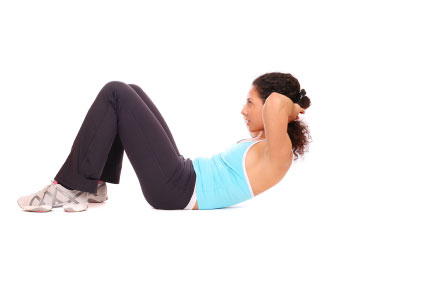Why Aren’t Sit Ups Safe After Birth?
The Fitness Industry, like many other industries, is an ever-changing one. It’s full of trends. Exercises come in and out of fashion, research is done to prove exercises safe or unsafe, and as Fitness Professionals, we listen and make changes to our program content accordingly.
Sit-ups, or any variation of this movement where you go into forward flexion eg when lying on your back, you bring your torso towards your knees to work the six pack muscle, is considered contra-indicated for postnatal women. Contra-indicated meaning, performing this exercise can cause more harm than good. So, if you’ve recently had a baby and you’re doing sit ups, STOP them immediately. Sit ups after birth aren’t a good idea.
The first thing your six-pack muscle (Rectus Abdominis) does during pregnancy is lengthen, vertically. Then, as your pregnancy develops, and your baby grows and your bump gets bigger, this muscle starts to separate around your belly button. The abdominals can take time to re-align after your baby has been born, so for several weeks and indeed months after birth, your six-pack muscle remains in a lengthened, separated state.
The first thing we need to do regarding this area is actually focus on strengthening your pelvic floor which is a bit like a sling of muscles supporting you from underneath, then locate the deep abdominal muscles which lie under your six-pack muscle. These deep muscles are known as the Transversus Abdominis (TvA).
Strengthening the abdominals after birth, and specifically the TvA and pelvic floor, is a bit like building a house. If your house has a solid framework and foundations, it will always be strong. If you work on strengthening the deepest muscles first, then focus on the next layer, then the next layer after that, then your abdominals will re-align to their original structure.
What do sit-ups do? Well, sit-ups strengthen and work the six-pack muscle. During pregnancy, we know that this muscle has lengthened and separated. If you don’t have a solid foundation underneath this six-pack muscle before you work it (I’m talking about your core and pelvic floor here), then by doing sit-ups, you’re actually going to make your separation worse. In other words, any separation you had after birth, will now be wider, because you’re forcing the muscle to strengthen, when it’s still in a weakened, separated state. The amount of abdominal pressure placed on the six-pack muscle when performing a sit-up, forces it to separate further apart. Your pelvic floor will also take the brunt of this contraction too.
As a Postnatal Instructor, I follow a system for my postnatal clients which involves locating the TvA first. We set strengthening exercises, along with lots of focus on the pelvic floor. Once strength in these muscle groups has been gained, work is then done to help “shorten” the six-pack muscle (because it’s still in a lengthened state, remember), and finally finish with “strength” work.
The best type of exercise to do for your abdominals, postnatally focuses on your pelvic floor and TvA, and by attending a postnatal-specific exercise class, will ensure that your workout stays safe and effective.
So, “Why do people do sit-ups?”. Well, in most cases, people do sit-ups in the hope that they will get themselves a toned, flat stomach and a noticeable six-pack. As a postnatal women doing sit-ups AREN’T going to help you, or anyone you know, male or female, get that six-pack you’ve always strived for. Your body needs to be extremely lean to do this, and, you guessed it, the foundation ie your TvA and pelvic floor needs to be strong and toned!
So, to get a six-pack, there are three things you need to do: a) clean up your diet, b) make fat-burning exercise part of your routine (the best way to burn fat, is to build lean muscle eg body weight/ weight/resistance training), and c) work your pelvic floor and TvA
Join me on my next Postnatal Workshop – click here to book or if you want to be notified of our next event email us.
